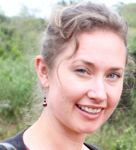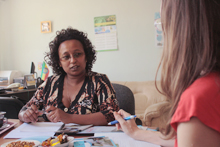
Nursing and Midwifery Education in Ethiopia: Ensuring Professional Capacity and Relevance
 It has been estimated that sub-Saharan Africa needs 600,000 additional nurses just to meet the Millennium Development Goals. The United States Government’s Nursing Education Partnership Initiative (NEPI) is designed to strengthen the quality and capacity of nursing and midwifery education systems in sub-Saharan African countries, to increase the number of well-qualified nurses and midwives, and to support innovative retention strategies. Nurses and midwives are integral to health systems, providing care to underserved areas and filling in where and when doctors are in short supply. CapacityPlus is proud to be a NEPI partner, providing analysis and technical support to the Democratic Republic of the Congo and Ethiopia.
It has been estimated that sub-Saharan Africa needs 600,000 additional nurses just to meet the Millennium Development Goals. The United States Government’s Nursing Education Partnership Initiative (NEPI) is designed to strengthen the quality and capacity of nursing and midwifery education systems in sub-Saharan African countries, to increase the number of well-qualified nurses and midwives, and to support innovative retention strategies. Nurses and midwives are integral to health systems, providing care to underserved areas and filling in where and when doctors are in short supply. CapacityPlus is proud to be a NEPI partner, providing analysis and technical support to the Democratic Republic of the Congo and Ethiopia.
Nursing and midwifery education in Ethiopia
In February, Dr. Kate Tulenko and I traveled to Addis Ababa, Ethiopia to meet with government stakeholders and implementing partners to discuss the implementation of CapacityPlus’s nursing and midwifery education capacity assessment and costing studies for the NEPI program in Ethiopia.
In Ethiopia, the national health worker ratio is 0.84 health workers per 1,000 people, well below the 2.3 per 1,000 ratio identified by the World Health Organization as the minimum threshold needed to provide adequate coverage with life-saving health services. The Health Development Strategy Program (HDSP-IV), led by the country’s Federal Ministry of Health, is committed to scaling up the health workforce, including nurses and midwives.
 (2).jpg)
In Addis, we heard from stakeholders about the challenges of assuring the quality of nursing and midwifery graduates as the country rolls out its strategy for scale-up. One important challenge is the need to increase opportunities for clinical rotations, especially in rural areas, to ensure that the students gain relevant skills and understand what kinds of jobs and work environment they will face when posted.
Ethiopia’s nursing and midwifery education capacity assessment will be conducted at several universities and health science colleges in 2012. In addition, some schools will undertake a costing exercise to develop a package of interventions that would offer the greatest return on investment possible.
The maturity of midwifery
 Kate and I also had the privilege to meet with Ms. Hiwot Wubshet, the executive director of the national Ethiopian Midwives Association (EMA). Welcomed to her office on Haile Selassie Avenue with spiced tea and kolo, we were impressed by EMA’s headquarters, including an extensive library of midwifery literature. Shelves upon shelves of brochures in Amharic and English lined the walls. “That is because it is an office of women,” Ms. Wubshet laughed.
Kate and I also had the privilege to meet with Ms. Hiwot Wubshet, the executive director of the national Ethiopian Midwives Association (EMA). Welcomed to her office on Haile Selassie Avenue with spiced tea and kolo, we were impressed by EMA’s headquarters, including an extensive library of midwifery literature. Shelves upon shelves of brochures in Amharic and English lined the walls. “That is because it is an office of women,” Ms. Wubshet laughed.
As a professional association, EMA provides professional resources and support to its 1,300 members. They are striving to find ways to reach midwives in the most remote areas of Ethiopia, those who may most benefit from additional support. There are at least 1,400 additional practicing midwives throughout the country that are not part of the EMA.
The association is currently working on developing an electronic database of all midwives in order to identify areas without sufficient numbers of practicing midwives. It will also encourage midwives to participate in and learn from a professional network, which can be a significant factor in ensuring that health workers have relevant skills and are motivated to work. We were able to provide some recommendations on how the association could better extend its reach to rural areas and engage its members to be more active.
What kind of person is attracted to midwifery? “Midwifery needs maturity,” Ms. Wubshet reflected. “You need to feel the mother’s pain.” It is important that women and men who enter the profession have a genuine interest in midwifery. In part, the clinical practica that midwives in training are exposed to can be a transformative experience in their professional development. Ms. Wubshet fondly recalled the time she spent in training at a teaching hospital when she and a fellow student would each deliver three babies a night. She was “very motivated by maternity,” Ms. Wubshet confessed. And from this positive experience she grew into a fearless advocate for midwives everywhere.
Related items:
Photo 1 by Nigel Pavitt. Photo 2 courtesy of Rachel Deussom. (Rachel and Kate Tulenko with government stakeholders) Photo 3 by Rachel Deussom. [Ms. Hiwot Wubshet (left) talking to Kate Tulenko (right)]


